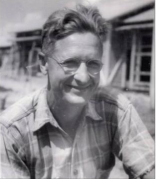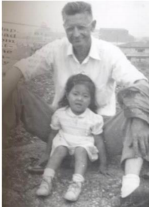Virtual Screening and Q&A for “Houses for Peace: Exploring the Legacy of Floyd Schmoe” to Mark the 75th Anniversary of the End of World War II
HONOLULU, HI (July 23, 2020) – The Battleship Missouri Memorial has partnered with NHK WORLD-JAPAN, the English-language international service of Japan’s public media organization, NHK, to feature a special virtual screening and Q&A for the documentary “Houses for Peace: Exploring the Legacy of Floyd Schmoe.” This special screening is in commemoration of the 75th anniversary of the end of World War II. This event is presented by the Japanese American National Museum (JANM) in Los Angeles, and in cooperation with the Hiroshima Peace Memorial Museum and the Battleship Missouri Memorial.
Houses for Peace (2018) tells the story of Floyd Schmoe, an American who traveled to the atomic-bombed city of Hiroshima more than 70 years ago on a mission of peace. Leading a diverse group of volunteers from the U.S. and Japan, he built houses for survivors of the atomic bomb and their families. It was a finalist for the 2019 Asian Academy Creative Awards (Documentary Category).
The documentary will be available for one year on NHK WORLD-JAPAN’s video on demand service beginning July 19, 2020 (July 20, 2020, JST).
A Q&A session featuring Mike Carr, president and CEO of the USS Missouri Memorial Association is scheduled to be live streamed on August 5, 2020 at 4:00 p.m. The session will also feature 75-year-old atomic bomb survivor Koko Kondo who spent time with Schmoe as a young girl, and the documentary’s director, Kumiko Ogoshi Takai. Together they’ll discuss what viewers today can learn from the story of Schmoe, a lifelong grassroots peacebuilder.
The Q&A is free and open to the public. However, advance registration is required. Please RSVP to janm.org/events. You will be emailed links and instructions to join the event via Zoom. For more information, contact publicprograms@janm.org.
To further commemorate the 75th anniversary of the end of World War II and strengthening the partnership between Hawaii and Japan, the Battleship Missouri Memorial will be opening a temporary traveling exhibit featuring artifacts from the Hiroshima Peace Museum. The exhibit will follow the 75th anniversary of the atomic bombings and provide guests of the Mighty Mo an opportunity to view one-of-a-kind artifacts, including brick fragment, melted crucifix, exposed roof tile, clothing articles from students and more.

Caption: Floyd Schmoe (1895 – 2001)
Donated by: Brooks Andrews
Photo Courtesy: Hiroshima Peace Memorial Museum

Caption: Floyd Schmoe and Koko Kondo
Donated by: Sumiko Kitazawa
Entrusted by: the Group for Learning from Floyd Schmoe
Photo Courtesy: Hiroshima Peace Memorial Museum
Battleship Missouri Memorial
Since opening in January 1999, the Battleship Missouri Memorial has attracted more than 9-million visitors from around the world with a fascinating tour experience showcasing the USS Missouri’s unique place in history. Located a mere ship’s length from the USS Arizona Memorial, the Mighty Mo completes a historical visitor experience that begins with the “day of infamy” and sinking of the USS Arizona in Pearl Harbor on December 7, 1941 and ends with Japan’s formal surrender aboard the USS Missouri in Tokyo Bay on September 2, 1945.
The USS Missouri had an astounding career over five decades and three wars – World War II, the Korean War, and Desert Storm – after which it was decommissioned and donated to the USS Missouri Memorial Association, Inc., a 501(c)(3) non-profit organization. The Association operates the Battleship Missouri Memorial as a historic attraction and oversees her care and preservation with the support of visitors, memberships, grants, and donations.
Japanese American National Museum (JANM)
The mission of the Japanese American National Museum is to promote understanding and appreciation of America’s ethnic and cultural diversity by sharing the Japanese American experience. JANM is the first museum in the United States dedicated to sharing the experience of Americans of Japanese ancestry as an integral part of U.S. history.
Through its comprehensive collection of Japanese American objects, images and documents, as well as multi-faceted exhibitions, educational programs, documentaries and publications, JANM shares the Japanese American story with a national and international audience.
To commemorate the upcoming 75th anniversary of the bombings of Hiroshima and Nagasaki, the Japanese American National Museum presents Under a Mushroom Cloud: Hiroshima, Nagasaki, and the Atomic Bomb, organized in partnership with the cities of Hiroshima and Nagasaki.
NHK (Japan Broadcasting Corporation), Japan’s public broadcaster, operates the nation’s largest domestic and international television network. In Japan, NHK broadcasts four TV channels and three radio stations. NHK also transmits two international television channels, NHK WORLD-JAPAN (English, HD, 24/7) and NHK WORLD PREMIUM (Japanese, HD, 24/7), as well as international radio services in 18 languages. NHK WORLD-JAPAN reaches over 300 million households in 160 countries and regions via local satellite and cable TV providers.
- Available in Los Angeles: KCETLink through a dedicated over-the-air channel (Channel 28.3), Spectrum (Channel 1277/194/254), Xfinity (Channel 372), Cox (Channel 812), DirecTV (Channel 322/2049), and U-verse (Channel 1221)
- Available in Hawaii: Spectrum (Channel 682/1682), Hawaiian Telcom (Channel 21/1021)
Online livestreaming and video on demand (VOD) services through a free mobile app and website give viewers access to NHK WORLD-JAPAN anywhere, anytime. Viewers can also connect through Roku, Fire TV, and Apple TV. Presenting an extensive range of Asia-centered programming, NHK WORLD-JAPAN is your window on Japan, Asia, and the world. For more information, visit https://www.nhk.or.jp/nhkworld/.
Hiroshima Peace Memorial Museum
At 8:15 a.m., August 6, 1945, the world’s first atomic bomb used against human beings exploded over Hiroshima. Instantly, an entire city crumbled and burned. Hundreds of thousands of its people perished. Those who managed to survive suffered grievous mental and physical trauma, from which many suffer to this day.
The Hiroshima Peace Memorial Museum opened in August 1955, mandated to convey the facts of the atomic bombing, thus contributing to the abolition of nuclear weapons and the realization of genuine and lasting world peace.
The Museum collects and displays belongings left by the victims, photos, and other materials that convey the horror of that event, supplemented by exhibits that describe Hiroshima before and after the bombing and others that present the current status of the nuclear age. Each of the items displayed embodies the grief, anger, or pain of real people. Having now recovered from that A-bomb calamity, Hiroshima’s deepest wish is the elimination of all nuclear weapons and the realization of a genuinely peaceful international community.
# # #
Media Contact:
Shere’e Quitevis
(808) 741-1668
Sheree.Quitevis@AnthologyGroup.com
Jaclyn Hawse
(808) 455-1600 ext. 246
JaclynH@ussmissouri.org



